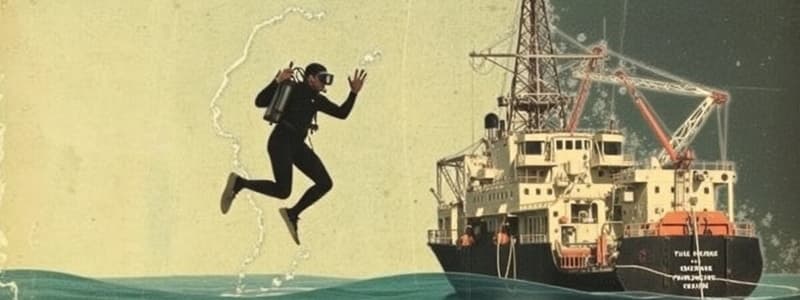Podcast
Questions and Answers
During the subsea spool tie-in operations described, what primary factor led the Diving Supervisor to incorrectly assume the crane hook had reached the seabed?
During the subsea spool tie-in operations described, what primary factor led the Diving Supervisor to incorrectly assume the crane hook had reached the seabed?
- The crane operator reporting 'no weight' on the crane wire. (correct)
- Failure of the locating beacons attached to the crane block.
- The crane operator's lack of experience with subsea operations.
- Miscommunication between the dive team and the surface support vessel.
Which of the following actions would be MOST effective in preventing a recurrence of the incident described?
Which of the following actions would be MOST effective in preventing a recurrence of the incident described?
- Implementing a buddy system with more experienced divers.
- Providing divers with helmets made of stronger materials.
- Conducting pre-operation inspections of all rigging and lifting equipment. (correct)
- Increasing the frequency of safety meetings on the vessel.
In the context of subsea lifting operations with limited visibility, what is the purpose of utilizing additional locating beacons, underwater cameras, or sonar?
In the context of subsea lifting operations with limited visibility, what is the purpose of utilizing additional locating beacons, underwater cameras, or sonar?
- To deter marine life from approaching the work site.
- To better track the location of critical equipment like the crane hook. (correct)
- To provide real-time feedback to the crane operator.
- To allow divers to communicate more effectively with each other.
What control measure would MOST directly address the root cause of the crane hook striking the diver's helmet?
What control measure would MOST directly address the root cause of the crane hook striking the diver's helmet?
What immediate action demonstrated a positive safety response following the incident?
What immediate action demonstrated a positive safety response following the incident?
Flashcards
Incident Overview
Incident Overview
During subsea operations, a crane hook unexpectedly struck a diver's helmet due to misjudged distance and poor visibility.
Causes of the Incident
Causes of the Incident
Inadequate crane pennant length and poor visibility hindered accurate observation of the hook's position, leading to the incident.
Preventative Measures
Preventative Measures
Maintain safe distance between divers and crane hooks, enhanced visibility aids, and reinforced communications to prevent similar incidents.
Enhanced Visibility Aids
Enhanced Visibility Aids
Signup and view all the flashcards
Reinforced Communication
Reinforced Communication
Signup and view all the flashcards
Study Notes
- During subsea spool tie-in operations, a crane hook struck a diver’s helmet.
What Happened
- Divers worked on the seabed in poor visibility during subsea spool tie-in operations.
- After landing the pipe handling frame (PHF), the Diving Supervisor told the crane operator to lower the crane hook for rigging disconnection.
- The crane operator reported ‘no weight’ on the crane wire.
- The Diving Supervisor thought the hook reached the seabed.
- The diver started disconnecting the PHF.
- The crane hook unexpectedly struck the diver’s helmet while the diver was under the PHF.
- The diver was unharmed and returned to the dive bell.
- Inspection revealed the helmet was damaged beyond repair, including the side block.
- The helmet's integrity was maintained, showing its quality and durability.
- The diver was unharmed.
What Went Right
- Diver 2 helped Diver 1 to prevent injuries.
- Both divers returned to the bell safely.
- Locating beacons on divers and the crane block enabled accurate tracking.
- Procedures, lifting plans, and Job Hazard Analysis (JHAs) were followed.
- Protective equipment worked; the helmet absorbed the impact, preventing injury.
What Went Wrong
- The crane hook rested on the PHF's top beam during PHF rigging disconnection.
- This caused a ‘no weight’ reading, leading the crane operator to assume seabed contact.
- The hook slipped off the beam and struck the diver’s helmet as the diver approached the disconnection point.
What Was the Cause
- An inadequate crane pennant/stinger length did not provide enough distance between divers and the crane hook.
- Poor visibility hindered observing the crane hook's position.
Lessons and Actions
- Ensure adequate distance between divers and crane hook.
- The crane pennant/stinger should be long enough for a safe distance between divers and the crane hook, especially in limited visibility.
- Enhance visibility aids and monitoring
- Use methods like locating beacons, underwater cameras, or sonar to track equipment like the crane hook in poor visibility
- Improve monitoring to avoid misjudgments about equipment location.
- Reinforce communications and challenge assumptions.
- Minimize assumptions about equipment position.
- Reinforce clear communication between the dive supervisor, crane operator, and divers to ensure awareness of equipment location.
Member Actions
- Update project procedures to specify minimum pennant lengths for different operations.
- Conduct pre-operation inspections of rigging and lifting equipment, including crane hooks and pennants, to ensure safety standards.
- Update the Job Hazard Analysis (JHA) to include lessons on safe distances, visibility, and communication for subsea lifting.
Studying That Suits You
Use AI to generate personalized quizzes and flashcards to suit your learning preferences.




